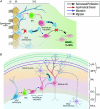Defining the role of GABA in cortical development
- PMID: 19153158
- PMCID: PMC2689328
- DOI: 10.1113/jphysiol.2008.167635
Defining the role of GABA in cortical development
Abstract
Of the many signals in the developing nervous system, GABA (gamma-aminobutyric acid) has been shown to be one of the earliest neurotransmitters present. Unlike in the adult, where this transmitter acts synaptically to inhibit neurons, during development, GABA can depolarize progenitor cells and their progeny due to their high intracellular chloride concentration. This early form of GABA signalling may provide the main excitatory drive for the immature cortical network and play a central role in regulating cortical development. Many features of GABA signalling are conserved in different species and are recapitulated during neurogenesis in the adult brain, demonstrating the importance of this versatile molecule in driving cortical formation. Here, we present recent evidence supporting the multiple functions of GABA during embryonic development and adult neurogenesis, from regulating progenitor proliferation to influencing the migration and maturation of newborn neurons.
Figures


References
-
- Andang M, Hjerling-Leffler J, Moliner A, Lundgren TK, Castelo-Branco G, Nanou E, Pozas E, Bryja V, Halliez S, Nishimaru H, Wilbertz J, Arenas E, Koltzenburg M, Charnay P, El Manira A, Ibanez CF, Ernfors P. Histone H2AX-dependent GABAA receptor regulation of stem cell proliferation. Nature. 2008;451:460–464. - PubMed
-
- Andang M, Lendahl U. Ion fluxes and neurotransmitters signaling in neural development. Curr Opin Neurobiol. 2009 in press. - PubMed
Publication types
MeSH terms
Substances
LinkOut - more resources
Full Text Sources
Other Literature Sources

